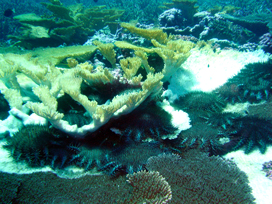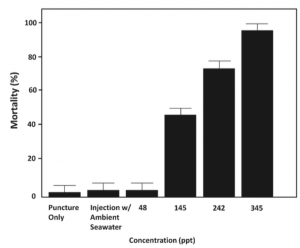Innovations in controlling crown-of-thorns sea star outbreaks
By Grace Roskar, SRC Intern
Acanthaster planci, commonly known as the crown-of-thorns sea star (COTS), are a species of sea star that can reach up to half a meter in diameter, have up to 15 arms, and therefore are one of the largest species of starfish in the world (Lucas 2013). The “crown of thorns” on the starfish refers to the sharp spines on its topside that contain a toxin that can cause and irritate puncture wounds (Lucas 2013). At normal population densities, COTS play essential roles in the food webs of coral reef ecosystems (Moutardier et al. 2015). However, when outbreaks occur and their population density greatly increases in relatively concentrated areas, COTS become a problem. Outbreaks are considered to occur when the density of COTS is over 1,500 starfish per square kilometer (Pratchett 2005). By pushing their stomachs out through their mouths on the underside of their bodies, COTS feed on and digest the live tissue of hard corals. Algae can then invade the coral and recovery of the hard coral can be inhibited. COTS can feed on an area of coral the size of its own body at a time, and due to their large size, COTS outbreaks have been considered the “most severe biological disturbance experienced by coral reefs across the Indo-Pacific, from the coast of South Africa to the Gulf of California,” (de Dios et al. 2015). For example, from 1985 to 2012, hard coral cover on Australia’s Great Barrier Reef declined from 28% to 13.8%, and COTS caused 42% of the decrease (Lucas 2013).

A COTS outbreak at Kingman Reef in the North Pacific. Photo Credit: Molly Timers, NOAA PIFSC
In Pacific nations where these outbreaks occur, citizens often rely on the coral reefs for economic sustenance, and therefore COTS outbreaks are a “recurrent threat to food security and the coastal communities’ lifestyle,” (Moutardier et al. 2015). Although COTS outbreaks are a serious threat to coral reef biodiversity, most affected countries do not have sufficient monitoring programs to assess the outbreaks and devastation, and thus the outbreaks are not well understood (Pratchett et al. 2009). However, several methods to control outbreaks have been utilized by different nations over the years. Two relatively recent methods involve 1) using a hypersaline solution, and 2) using lime juice and acetic acid to try to control COTS outbreaks.
COTS are osmoconformers, keeping the salt concentration of their internal fluids the same as that of the surrounding seawater by allowing seawater to flow in and out through an opening on their body called the madreporite (Bradley 2009). Sea stars and other echinoderms lack excretory organs to spend energy on actively regulating their osmotic pressure, thus sudden changes in salt concentration in their internal cavity would cause physiological stress to COTS (de Dios et al. 2015). de Dios et al. (2015) studied the effect of injecting a hypersaline solution into COTS to see if this would cause physiological stress and eventually lead to death. To test this, after injection, they measured the time it took for the COTS to turn themselves from an inverted position to right-side up, called the righting response. This response has previously been used as “an indicator of sub-lethal stress” because the movement requires neuromuscular coordination (de Dios et al. 2015).
The COTS were injected with hypersaline solutions of various salinities and the time it took the COTS to right themselves was recorded. It was found that most of the COTS remained upside down for more than fifteen minutes and were considered to be comatose. Increasing the salt concentration decreased the time it took for the COTS to become comatose. Thus, highly concentrated salt solutions (i.e. 345 ppt) had significant health effects on COTS. Increased salt solutions resulted in an increased percent of comatose sea stars, which lead to increased mortality rates. When the sea stars were injected with concentrated saline solutions, their ionic composition became unbalanced, which eventually led to their comatose state and even death (de Dios et al. 2015). Overall, the study showed that COTS cannot maintain a “large ionic gradient and large osmotic pressure at hypersaline concentrations (i.e. 145–429 ppt),” (de Dios et al. 2015). Injecting hypersaline solutions is a less harmful control method compared to irritating acids (e.g. copper sulfate) that have previously been employed to control COTS outbreaks. It is also less expensive, more readily available worldwide, and is a natural product (de Dios et al. 2015).

The mortality rate of crown-of-thorns sea stars 24 hours after injection with saline solutions of various concentrations (de Dios et al. 2015).
Injecting lime juice and/or acetic acid into the sea star is another relatively newer method to control COTS outbreaks. Acetic acid is the main ingredient of household white vinegar, and lime juice contains citric acid. Moutardier et al. (2015) tested these acids on COTS because acetic acid has previously been found to kill COTS, but lime juice had not been tested before. COTS were injected with acetic acid, lime juice, or a solution of both, in various volumes, and the time it took for death to occur was recorded. Moutardier et al. (2015) found that high mortality was observed, “regardless of the solution or volume injected.” There was no significant difference between mortality from acetic acid only and mortality from lime juice only. The average time to death was 29.8 hours for acetic acid and 34.3 hours for lime juice. The study also found that double-shot injections caused death the quickest: within 24 hours for every COTS tested, under both experimental and field conditions (Moutardier et al. 2015).
The low pH of acids led to stress in the COTS, causing changes in “various physiological mechanisms and causing failure of the immune system and reproductive functions,” (Moutardier et al. 2015). The results of the study show that citric or acetic acid injections can be an effective way to kill COTS and control outbreaks. The advantages of using this method include low costs, low harm to those handling the solution, and wider worldwide availability than other acids. Fish, corals, and other benthic invertebrates in the experimental field were observed for any adverse effects from injecting nearby COTS, but no immediate or delayed effects were found (Moutardier et al. 2015). Although extensive studies have not been performed, this may suggest that the lime juice and acetic acid solutions have little to no side effects in the surrounding coral reef ecosystem.
These two innovative methods of controlling COTS outbreaks have advantages and disadvantages. Saline solutions, acetic acid, and lime juice are all inexpensive, natural materials that are widely available and are even common in most households. They are safe for humans to handle and do not require any permits to use. However, these methods are only short-term responses to COTS outbreaks. COTS can be found at depths farther than snorkeling can occur, so SCUBA divers would be needed for injections at depth, which requires further resources from the community.
Hypersaline solution injections and acetic acid and lime juice injections are two innovative methods that have shown to be effective in killing crown-of-thorns sea stars in experimental and field trials. They are suitable for remote communities or nations with limited resources. Yet, COTS outbreaks still remain difficult to control due to size, numbers, depth, and other factors. Even with innovative efforts, outbreaks of A. planci remain a large threat to coral reef ecosystems around the world and have proven to be a difficult problem to solve.
References:
Bradley, Timothy J. “Osmoconformers.” Animal Osmoregulation. Oxford: Oxford UP, 2009. N. pag. Oxford Scholarship Online. Web. 8 Nov. 2015. <10.1093/acprof:oso/9780198569961.001.0001>.
de Dios, Homer Hermes Y., Filipina B. Sotto, Danilo T. Dy, and Anthony S. Ilano. “Response of Acanthaster Planci (Echinodermata: Asteroidea) to Hypersaline Solution: Its Potential Application to Population Control.” Galaxea, Journal of Coral Reef Studies 17 (2015): 23-30. J-Stage. Web. 8 Nov. 2015. <http://doi.org/10.3755/galaxea.17.23>.
Lucas, John S. “Quick Guide: Crown-of-thorns Starfish.” Current Biology 23.21 (2013): R945-946. ScienceDirect. Web. 8 Nov. 2015. <doi:10.1016/j.cub.2013.07.080>.
Moutardier G, Gereva S, Mills SC, Adjeroud M, Beldade R, Ham J, et al. (2015) Lime Juice and Vinegar Injections as a Cheap and Natural Alternative to Control COTS Outbreaks. PLoS ONE 10(9): e0137605. doi:10.1371/journal.pone.0137605
Pratchett, M. S., T. J. Schenk, M. Baine, C. Syms, and A. H. Baird. “Selective Coral Mortality Associated with Outbreaks of Acanthaster Planci L. in Bootless Bay, Papua New Guinea.” Marine Environmental Research 67 (2009): 230-36. Elsevier. Web. 8 Nov. 2015. <doi:10.1016/j.marenvres.2009.03.001>.

